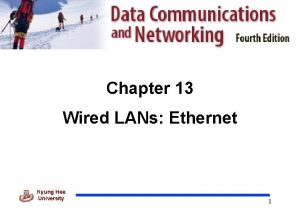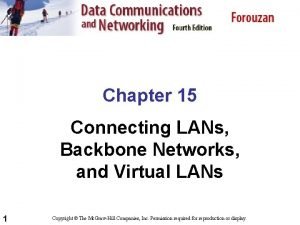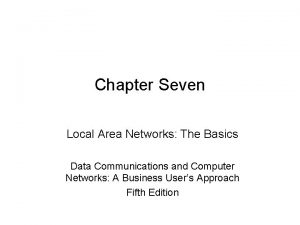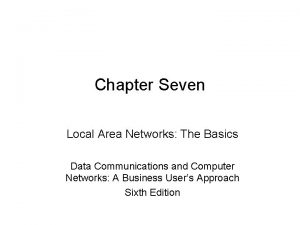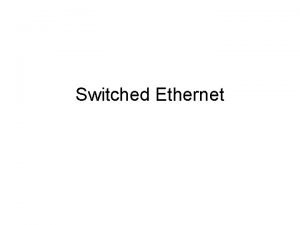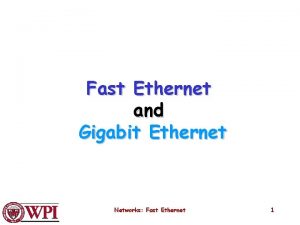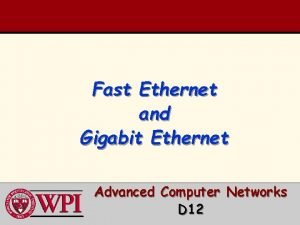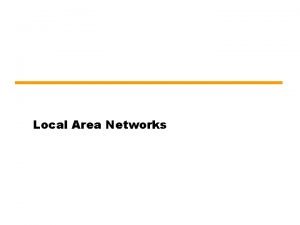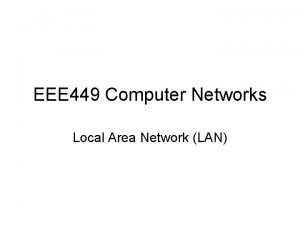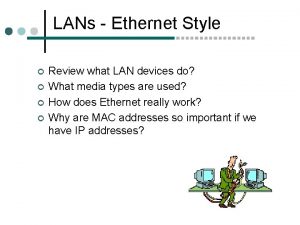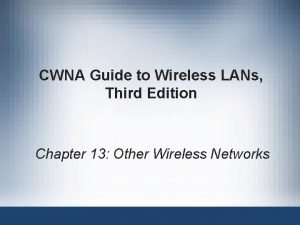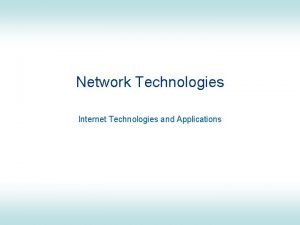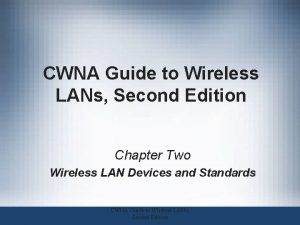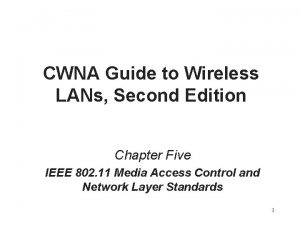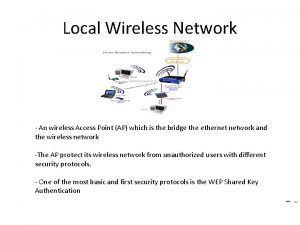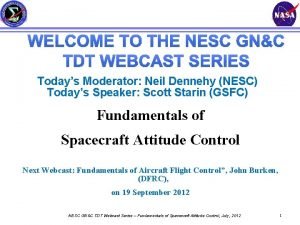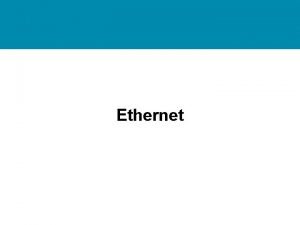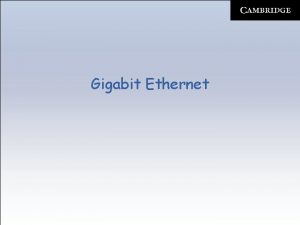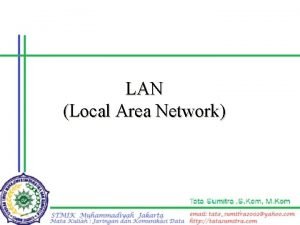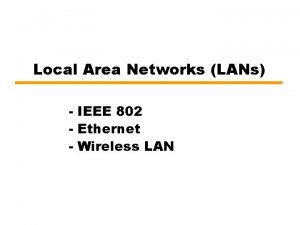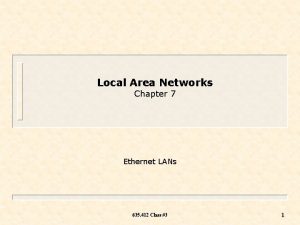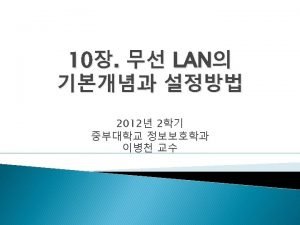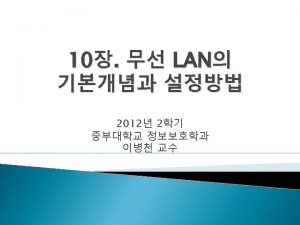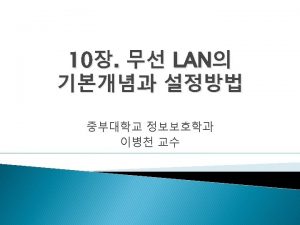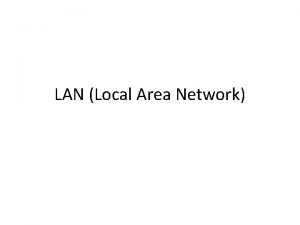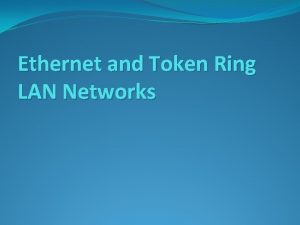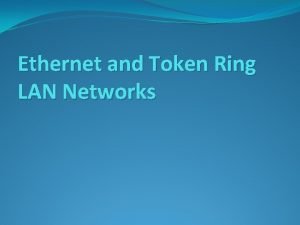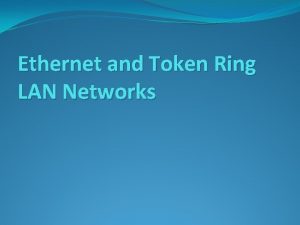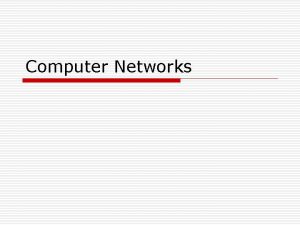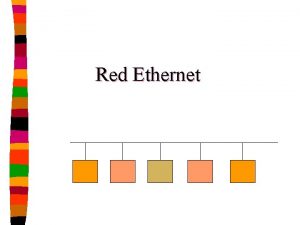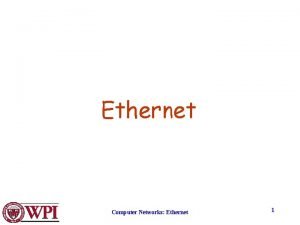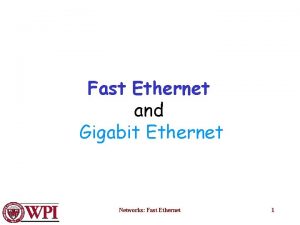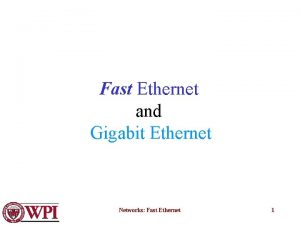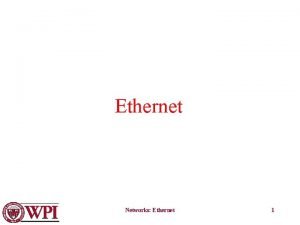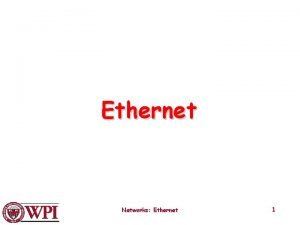Ethernet LAN 1 LANs u Local Area Networks























- Slides: 23

Ethernet LAN 1

LANs u Local Area Networks u Limited Geographical Area – Single office – Single building – University campus or industrial park u Generally, high speeds – Now, most operate at around 10 Mbps – 100 Mbps is emerging as the new “base speed” u Most Data Traffic is Local 2

Standards Setting u LANs are Subnets (single networks) u Subnet technology is Dominated by OSI Standards (true for LANs) u IEEE Creates most LAN Standards – Institute for Electrical and Electronic Engineers – Submits standards to ISO and ITU-T for ratification u IEEE 802 Committee – – LAN standards are set by the IEEE 802 Standards Committee. 802. 3 for Ethernet Standards 802. 5 for Token-Ring LAN Standards 802. 11 for Radio and Infrared Wireless LANs 3

LANs and OSI Architecture u OSI is a 7 -layer architecture u LAN transmission only uses Layers 1 and 2 u Layer 1: Physical Layer – Connectors, Media, Electrical signaling u Layer 2: Data Link Layer – Packaging data into frames – Managing transmission over link (error handling, etc. ) – Access control: when each station may transmit 4

OSI Physical and Data Link Layers Physical Layer (OSI Layer 1) Physical (plugs, media, etc. ); Electrical (voltages, timing, etc. ) Electrical Signal Station A Connector Plug F 4 -1 Station B Transmission Medium (telephone wire, etc. ) Connector Plug 5

OSI Physical and Data Link Layers Data Link Layer (OSI Layer 2) Frame 2 Station A Frame 1 Station B 6

Data Link Layer u For point-to-point transmission – A point-to-point connection is a data link – So is a transmission system shared by multiple devices, only one of which can transmit at a time because of collisions Transmission 7

Data Link Layer u First function: Packaging of Data (1 s and 0 s) – PDU at Data Link Layer is called a frame u Second Function: Access Control – Only one station can transmit at any time – If another transmitted, their signals would scramble one another – Must control access to (transmission into) the transmission medium 8

Data Link Layer OSI Data Link Layer (Layer 2) OSI Physical Layer (Layer 1) Logical Link Control Layer Media Access Control (MAC) Layer 802. 3 10 Base-T 10 Base-5 802. 3 Other Physical Layer 802. 5 Physical Layer 4 Mbps 802. 5 Physical Layer 16 Mbps Other Physical Layer OSI Data Link Layer is subdivided into two layers Media access control Logical link control 9

MAC Layer Media Access Control OSI Physical (Layer 1) Media Access Control (MAC) Layer 802. 3 10 Base-T 10 Base-5 802. 3 Other Physical Layer 802. 5 Physical Layer 4 Mbps 802. 5 Physical Layer 16 Mbps Other Physical Layer MAC layer implements media access control: When a station may transmit Controls the framing of data along the wire 10

Logical Link Control Layer LLC 802. 2 Logical Link Control Layer 802. 3 Media Access Control (MAC Layer) OSI Physical (Layer 1) 802. 3 10 Base-T 10 Base-5 802. 3 Other Physical Layer 802. 5 MAC 4 Mbps 802. 5 MAC 16 Mbps Other MAC 802. 5 Physical Layer 4 Mbps 802. 5 Physical Layer 16 Mbps Other Physical Layer Provides Control Function Begin/end connections between stations Error correction (optional) 11

Simple LAN Using Ethernet 10 Base-T Hub (Multiport Repeater) Unshielded Twisted Pair (UTP) Wiring (4 -Pair Bundle) PC NIC RJ-45 Jack RJ-45 jacks 10 Base-T UTP Wiring Bundles: 4 Pairs EIA Category 3, 4, or 5 Network Interface Card 12

NICs u Network Interface Cards – Implement Physical Layer t Plug and Electrical Signaling – Implements the Data Link Layer (data packaging, access control, etc. ) t LLC (802. 2) t MAC (802. 3 MAC) 13

Wiring u Unshielded Twisted Pair (UTP) – Twisted several times per foot to reduce interference, T in 10 Base- and Unshielded t t u No protection except for plastic coating Distance limitation: 100 meters (attenuation, distortion, noise and interference, crosstalk) -- propagation Categories of UTP Wiring – Category 5, 6: The best. Good for 100 Mbps – Category 3 and 4: lower. May be OK for 100 Mbps u Wiring Plugs: RJ-45 Standard – Similar to home (RJ-11) jacks, but wider 14

Layering in 802 Networks Internet Layer Data Link Layer TCP/IP Internet Layer Standards (IP, ARP, etc. ) Logical Link Control Layer Media Access Control Layer Physical Layer Other Internet Layer Standards (IPX, etc. ) 802. 2 Ethernet 802. 3 MAC Layer Standard 100 BASETX 1000 BASESX … Non-Ethernet MAC Standards (802. 5, 802. 11, etc. ) Non-Ethernet Physical Layer Standards (802. 11, etc. ) 15

Ethernet Physical Layer Standards UTP Physical Layer Standards 10 BASE-T Speed Maximum Medium Run Required Length 10 Mbps 100 meters 4 -pair Category 3 or higher 100 BASE-TX 100 Mbps 100 meters 4 -pair Category 5 or higher 1000 BASE-T (Gigabit Ethernet) 1, 000 Mbps 100 meters 4 -pair Category 5 or higher 100 BASE-TX dominates access links today, Although 1000 BASE-T is growing in access links today 16

Ethernet Physical Layer Standards Fiber Physical Layer Standards Speed Maximum Medium Run 850 nm light (inexpensive) Length Multimode fiber 1000 BASE-SX 1 Gbps 220 m 62. 5 microns 160 MHz-km 1000 BASE-SX 1 Gbps 275 m 62. 5 200 1000 BASE-SX 1 Gbps 500 m 50 400 1000 BASE-SX 1 Gbps 550 m 50 500 The 1000 BASE-SX optical fiber standard dominates trunk links today S means that the standard uses short wavelength light (850 nm) 17

Shared media LANs u Limits to Shared Media LANs – FDDI, 100 Base-X, 1000 Base-SX are all shared media LANs t Only one station can transmit at a time, causing latency t Every station hears every message, so as the number of stations grow, the LAN saturates – 100, 1000 Mbps speed only delays saturation 18

Switched LANs u In a switched network – Incoming frame arrives on a single port – Frame sent out again only on a single port--the one leading to the receiver – No congestion on other ports Switch 19

Switch With a switch, multiple stations may transmit simultaneously: no congestion as traffic grows. Station A Station B Switch Station C Connection 1 A-C Connection 2 B-D Station D Connection 2 B-D 20

Switch connections u paths called connections must be pre-defined between stations u a fixed logical data link (logical connection) is established between stations before transmission even begins u during the transmission, all traffic between the stations must pass over that data link u unless a data link has been pre-established, two stations may not communicate at all u only OSI Layer 2 (Data Link Layer) protocols are needed 21

Hierarchical Ethernet LAN Ethernet switches must be arranged in a hierarchical topology In a hierarchical LAN, there is only one possible path between any hosts 22

Routed LAN with Ethernet Subnets When a routed LAN links multiple Ethernet switched networks, individual switched networks are called subnets 23
 Lans
Lans Network that allows several lans to be connected is
Network that allows several lans to be connected is What are the basic layouts of local area networks
What are the basic layouts of local area networks What are the basic layouts of local area networks
What are the basic layouts of local area networks Switched ethernet vs shared ethernet
Switched ethernet vs shared ethernet Fast ethernet in computer networks
Fast ethernet in computer networks Fast ethernet in computer networks
Fast ethernet in computer networks Fast ethernet in computer networks
Fast ethernet in computer networks Fast ethernet in computer networks
Fast ethernet in computer networks High speed lans
High speed lans Lans
Lans Lans style
Lans style Cwna guide to wireless lans 3rd edition
Cwna guide to wireless lans 3rd edition Internet technologies and applications
Internet technologies and applications Show that the maximum efficiency of pure aloha is 1/(2e)
Show that the maximum efficiency of pure aloha is 1/(2e) Adam lans
Adam lans Cwna guide to wireless lans
Cwna guide to wireless lans Cwna guide to wireless lans
Cwna guide to wireless lans Unicast
Unicast A switch in a datagram network uses
A switch in a datagram network uses Backbone networks in computer networks
Backbone networks in computer networks Local wireless networks
Local wireless networks Local vertical local horizontal frame
Local vertical local horizontal frame A think local act local multicountry type of strategy
A think local act local multicountry type of strategy
